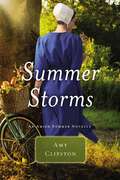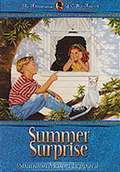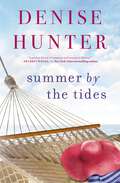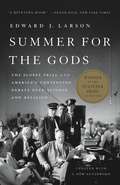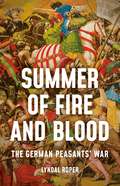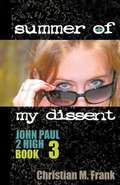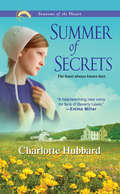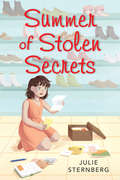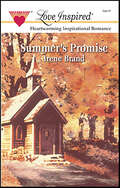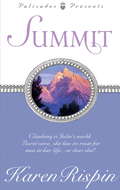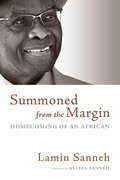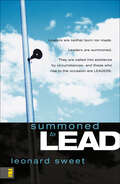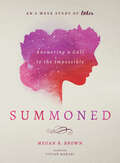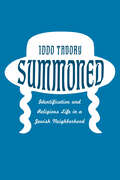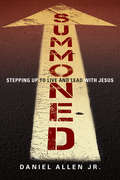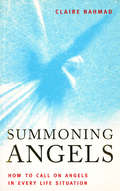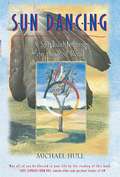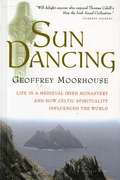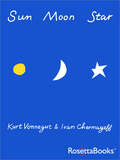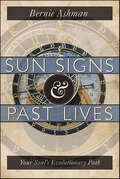- Table View
- List View
Summer Storms: An Amish Summer Novella
by Amy ClipstonArianna is counting down the days until her wedding to Jesse. They have been friends longer than Arianna can remember, and that friendship turned into love over the past couple of years. But when Arianna’s brother Isaac, who happens to be Jesse’s best friend, gets them both into trouble, Arianna’s father puts an end to her engagement to Jesse. Some summer storms pass quickly, but Arianna is afraid the damage from this one may be too much to repair.
Summer Surprise (Adventures of Callie Ann, Book #1)
by Shannon Mason LeppardBook 1 in The Adventures of Callie Ann. Callie is beside herself when her family moves to a new town. Away from all her friends, Callie's afraid no one will remember her birthday! Moving is always scary, and when you move from a big city to a small town where you don't know anyone in the middle of summer just before your birthday, you can feel very lost. Leaving behind your best friend and trying to find new things to enjoy can be a challenge. Make friends with Callie Ann and find out how she gets used to Cornelius.
Summer by the Tides
by Denise HunterOne of Southern Living’s “25 Beach Reads Perfect for Summer”“A perfect blend of romance and women’s fiction.” —SHERRYL WOODS, #1 New York Times bestselling authorA Summer of Low Tides Could Expose Years of Family SecretsWhen her grandmother goes missing from the family beach house, Maddy and her estranged sisters converge in Sea Haven, North Carolina. Being with uptight Nora and free-spirited Emma in the home where their family broke apart is a struggle Maddy is not in the mood to face, especially since she’s recovering from her ex-boyfriend’s betrayal.As the sisters wait for word of their grandmother, they begin to pack up the family belongings—and unpack memories of the idyllic summers of their childhood. But with those memories come long-buried secrets, and Maddy discovers that all was not as it appeared that last summer in Sea Haven. Meanwhile, Gram’s neighbor, Connor Sullivan, seems overly interested in Gram’s whereabouts. Maddy is drawn in by his quick smile and steady gaze in spite of herself.Undercurrents of jealousy and resentment threaten to pull the family under again, maybe for good this time. As tensions rise, the sisters must find a way to accept each other for the women they’ve become—and Maddy must decide if falling in love again is worth the potential heartbreak.“I have never read a romance by Denise Hunter that didn’t sweep me away into a happily ever after. Treat yourself!” —Robin Lee Hatcher, bestselling author of Who I Am With You“Denise Hunter once again proves she’s the queen of romantic drama. Summer by the Tides is both a perfect beach romance and a dramatic story of second chances as sisters unravel secrets that have torn them apart for years. This novel is Hunter at the top of her game. If you like Robyn Carr, you’ll love Denise Hunter. I couldn’t put it down!” —Colleen Coble, USA Today bestselling author of the Lavender Tides series
Summer for the Gods: The Scopes Trial and America's Continuing Debate Over Science and Religion
by Edward J. LarsonThe Pulitzer Prize-winning history of the Scopes Trial and the battle over evolution and creation in America's schools.In the summer of 1925, the sleepy hamlet of Dayton, Tennessee, became the setting for one of the twentieth century's most contentious courtroom dramas, pitting William Jennings Bryan and the anti-Darwinists against a teacher named John Scopes, represented by Clarence Darrow and the ACLU, in a famous debate over science, religion, and their place in public education. That trial marked the start of a battle that continues to this day in cities and states throughout the country. Edward Larson's classic Summer for the Gods -- winner of the Pulitzer Prize in History -- is the single most authoritative account of this pivotal event. An afterword assesses the state of the battle between creationism and evolution, and points the way to how it might potentially be resolved.
Summer for the Gods: The Scopes Trial and America's Continuing Debate Over Science and Religion
by Edward LarsonIn the summer of 1925, the sleepy hamlet of Dayton, Tennessee, became the setting for one of the 20th century's most contentious dramas: the Scopes trial that pit William Jennings Bryan and the anti-Darwinists against a teacher named John Scopes into a famous debate over science, religion, and their place in public education That trial marked the start of a battle that continues to this day-in Dover, Pennsylvania, Kansas, Cobb County, Georgia, and many other cities and states throughout the country. Edward Larson's classic, Summer for the Gods, is the single most authoritative account of a pivotal event whose combatants remain at odds in school districts and courtrooms. For this edition, Larson has added a new preface that assesses the state of the battle between creationism and evolution, and points the way to how it might potentially be resolved.<P><P> Pulitzer Prize Winner
Summer of Fire and Blood: The German Peasants' War
by Lyndal RoperIn this &“extraordinary and brilliant book&” (Helen Castor, author of She-Wolves), a prize-winning historian offers the definitive account of the sixteenth-century uprising that revolutionized Europe The German Peasants&’ War was the greatest popular uprising in Western Europe before the French Revolution. In 1524 and 1525, it swept across Germany with astonishing speed as well over a hundred thousand people massed in armed bands to demand a new and more egalitarian order. The peasants took control of vast areas of southern and middle Germany, torching and plundering the monasteries, convents, and castles that stood in their way. But they proved no match for the forces of the lords, who put down the revolt by slaying somewhere between seventy and a hundred thousand peasants in just over two months. In Summer of Fire and Blood, the first history of the German Peasants&’ War in a generation, historian Lyndal Roper exposes the far-reaching ramifications of this rebellion. Though the war&’s victors portrayed the uprising as naive and inchoate, Roper reveals a mass movement that sought to make good on the radical potential of the Protestant Reformation. By recovering what the people themselves felt and believed, Summer of Fire and Blood reconstructs the thrilling, tragic story of the peasants&’ fight to change the world.
Summer of Light
by W. Dale CramerMick Brannigan, a construction worker, loses a good-paying Job. Adding insult to injury, he finds himself playing nursemaid to his three kids. Mick isn't the stay-at-home-dad type. He's a good dad--when his wife is there to supervise it all ... the unrelenting daily stuff. Keeping the house clean, food in the fridge. Attacking the ever-mounting laundry. Supervising their five acres of land and the menagerie of animals.... "It wasn't his idea to stay home with the kids ... A lot is on the line, and just how the Brannigan family will survive remains to be seen...."
Summer of My Dissent (John Paul 2 High Book Three)
by Christian M. FrankBack Cover: "What if you had just lost your best friend and no one understood, especially your classmates at your small high school? It's Summertime and Allie is lonely. And questioning her faith. She's helping George, Celia and the Others fix up the rundown John Paul 2 High school building, but she feels lost in the crowd of bickering new kids and haunted by thoughts of her murdered friend. Then someone starts playing dangerous pranks at the school. Brian, Liz, and J.P. investigate until they realize that the evidence may point to... Allie..."
Summer of Secrets (Seasons of the Heart #1)
by Charlotte HubbardFirst in an Amish romance series from the author of the Promise Lodge novels, &“a heartwarming new voice for fans of Beverly Lewis&” (Emma Miller, author of An Amish Mystery series). Welcome to Willow Ridge, Missouri! In this cozy Amish town along the banks of the river, the Old Ways are celebrated at the Sweet Seasons Bakery Café, and love is a gift God gives with grace . . . Summer has come to Willow Ridge, but Rachel Lantz is looking forward to a whole new season in her life—marriage to strapping carpenter Micah Brenneman, her childhood sweetheart. When a strange Englischer arrives in the café claiming to be the long-lost sister of Rachel and her twin Rhoda, Rachel feels the sturdy foundation of her future crumbling—including Micah&’s steadfast love. As the days heat up and tempers flare, Rachel and Micah will learn that even when God&’s plan isn&’t clear, it will always lead them back to each other . . . &“Hubbard centers her new inspirational series on the Sweet Seasons Café, where everyone in Willow Ridge, Mo., knows your name . . . those who enjoy a glimpse of the culture will find the story appealing.&”—Publishers Weekly &“Hubbard begins a new Amish series, Seasons of the Heart, with lovable characters who are learning that God has more in store for them than they realize. Hubbard will amaze readers with her knowledge of Amish living.&”—RT Book Reviews Seasons of the Heart series praise &“Fans of Amish fiction will love the Seasons of the Heart series.&”—Marta Perry, national bestselling author &“These very special books will sit proudly on my keeper shelf!&”—Romance Reviews Today
Summer of Stolen Secrets
by Julie SternbergA city girl spends the summer in the South and learns the secrets of her estranged extended family.Catarina has never met her strict Jewish grandmother. But now, with an opportunity to spend three weeks in Baton Rouge and away from her best-friends-turned-bullies, Cat packs her bags and leaves New York City to get to know the woman who has always been a mystery. Down South, she begins working at her grandmother's luxury department store with her rebellious cousin Lexie. Nothing seems to be going right and nobody talks about the past. But just when Cat is starting to think that this whole trip may have been a huge mistake, she stumbles onto a secret from a time her grandmother refuses to speak of. Suddenly Cat's summer, and everything she thought she knew, has changed.Award-winning author Julie Sternberg tells a tender family story full of humor, heart, and heartbreak that reveals the power of forgiveness and proves it's never too late to start over.
Summer's Promise
by Irene BrandTO EVERYTHING THERE IS A SEASONRural North Carolina was the last place military man David Brown ever expected to call home. Brought here by tragedy, he now shared guardianship of his niece and nephew with a woman he’d never dreamed would share his home-or his attraction....Wall Street banker Summer Weaver had never asked God for anything. Now she prayed for strength to care for her sister’s orphaned children-and found herself leaning on their uncle for support. Summer never imagined that footloose David could ever become so steadfast-or that she’d be willing to give up everything that had seemed important for something that mattered far more....
Summit
by Karen RispinJulie has loved rock climbing for as long as she can remember. What's more, she's good at it. Very good. So it only seems natural for her to do all she can to make a career out of it. But it's not easy. Not when there is so much resistance to women guides in the field ... and not when macho know-it-alls like David Hales keep showing up--and showing her up! Sure, David is internationally recognized. Sure, he's won competitions and awards. But that doesn't mean he's better than she is. All she has to do is convince her boss ... and herself. But what Julie doesn't know is that David isn't out to take her job. As a matter of fact, he's got something much different in mind ... something that has nothing to do with jobs or even rock climbing--and everything to do with love and faith in God.From the Trade Paperback edition.
Summoned from the Margin: Homecoming of an African
by Lamin SannehSummoned from the Margin tells the story of Lamin Sanneh's fascinating journey from his upbringing in an impoverished village in West Africa to education in the United States and Europe to a distinguished career teaching at the Universities of Yale, Harvard, Aberdeen, and Ghana. He grew up in a polygamous household in The Gambia and attended a government-run Muslim boarding school. A chance encounter with Helen Keller's autobiography taught him that education and faith are the key to overcoming physical and personal hardship and inspired his journey. Burning theological questions about God's nature and human suffering eventually led Sanneh to convert from Islam to Christianity and to pursue a career in academia. Here he recounts the unusually varied life experiences that have made him who he is today.Watch the trailer:
Summoned to Lead
by Dr. Leonard SweetLeadership Re-VisionedCast a vision, set a strategy, rally the troops, and take the hill—you don’t need another book to rehash the well-worn principles of modern leadership. But if you’re looking for something different, something that . . .approaches leadership as an art as well as a scienceinspires hope and expectation in those of us who aren’t born leaderschallenges those with leadership roles to explore new possibilities. . . then Leonard Sweet wants to help you discover a very different kind of leadership vision. It’s one you hear if your ears are open, and it could summon you at any time. When you respond, the puzzle pieces of who you are will fit together into a leader others follow because you’ve answered a call, not trained for a position. “The church has it all wrong. It is trying to train leaders. Instead, it ought to train everyone to listen and to develop their own soundtrack.”Leaders don’t see a vision, says Sweet, they hear one. “Sound becomes sight. Leaders hear life.”For a sonogram of “acoustic leadership,” Sweet takes us inside the incredible account of Sir Ernest Shackleton, the celebrated polar explorer who led his entire crew of twenty-seven from disaster in the Antarctic to safety. Called “the greatest leader that ever came on God’s earth, bar none,” Shackleton objectifies the goals of Sweet’s own exploration in search of wisdom for today and tomorrow’s truly compelling, voice-activated leaders.Right now, you may be leading many people or just yourself. But who knows what tomorrow—or a minute from now—will call forth in you. Are your ears open?
Summoned: Answering a Call to the Impossible: An 8-Week Study of Esther
by Megan B. BrownEncounter the fullness of God&’s grace, the power of His promises, and the beauty of His faithfulness—all through the life of one woman: Esther.In a time when the world around her seemed to crumble, a young Hebrew girl found herself in a unique position to help save her people—and to encounter the greatness of our ever-faithful God. In Summoned, you&’ll enter the story of Esther—her calling, pain, and role in God&’s ultimate plan for salvation—and see how God is always working in the lives of His people, even when He seems distant. Through this 8-week, interactive study, you&’ll develop a deeper appreciation for God&’s Word and begin to see that stepping out in faith for His glory is often the first step to encountering His redeeming love.
Summoned: Answering a Call to the Impossible: An 8-Week Study of Esther
by Megan B. BrownEncounter the fullness of God&’s grace, the power of His promises, and the beauty of His faithfulness—all through the life of one woman: Esther.In a time when the world around her seemed to crumble, a young Hebrew girl found herself in a unique position to help save her people—and to encounter the greatness of our ever-faithful God. In Summoned, you&’ll enter the story of Esther—her calling, pain, and role in God&’s ultimate plan for salvation—and see how God is always working in the lives of His people, even when He seems distant. Through this 8-week, interactive study, you&’ll develop a deeper appreciation for God&’s Word and begin to see that stepping out in faith for His glory is often the first step to encountering His redeeming love.
Summoned: Identification and Religious Life in a Jewish Neighborhood
by Iddo TavoryOn a typical weekday, men of the Beverly-La Brea Orthodox community wake up early, beginning their day with Talmud reading and prayer at 5:45am, before joining Los Angeles' traffic. Those who work "Jewish jobs"--teachers, kosher supervisors, or rabbis--will stay enmeshed in the Orthodox world throughout the workday. But even for the majority of men who spend their days in the world of gentiles, religious life constantly reasserts itself. Neighborhood fixtures like Jewish schools and synagogues are always after more involvement; evening classes and prayers pull them in; the streets themselves seem to remind them of who they are. And so the week goes, culminating as the sabbatical observances on Friday afternoon stretch into Saturday evening. Life in this community, as Iddo Tavory describes it, is palpably thick with the twin pulls of observance and sociality. In Summoned, Tavory takes readers to the heart of the exhilarating--at times exhausting--life of the Beverly-La Brea Orthodox community. Just blocks from West Hollywood's nightlife, the Orthodox community thrives next to the impure sights, sounds, and smells they encounter every day. But to sustain this life, as Tavory shows, is not simply a moral decision they make. Being Orthodox is to be constantly called into being. People are reminded of who they are as they are called upon by organizations, prayers quorums, the nods of strangers, whiffs of unkosher food floating through the street, or the rarer Anti-Semitic remarks. Again and again, they find themselves summoned both into social life and into their identity as Orthodox Jews. At the close of Tavory's fascinating ethnography, we come away with a better understanding of the dynamics of social worlds, identity, interaction and self--not only in Beverly-La Brea, but in society at large.
Summoned: Stepping Up to Live and Lead with Jesus
by Daniel Allen Jr.You have been summoned. Life is complicated, and sometimes we feel stuck or adrift. But God has been at work in your life, and he's still working in you. God is calling men to a deeper life of faith, surrender and commitment. You can learn to recognize where he's leading you and what he's calling you to become. Leadership coach Daniel Allen knows what it's like to be summoned by God. He shares how he heard God's wake-up call on his life and what it takes to find a life of fulfillment, passion and purpose. This honest guide gives practical, real-life advice for shaping a godly view of manhood, building character and growing in spiritual practices and leadership. From his own experience, Allen addresses common pitfalls that trip men up and shows how you can thrive in your faith, vocation and relationships. Including a four-session study guide for men, this book shows how God is shaping you into a leader, and that he is sending you out to serve others around you. There's more to this life. Step up and answer the call to deeper discipleship.
Summoning Angels
by Claire NahmadThe time will come again when angels will walk with men: that is the glorious message Claire Nahmad has for us. But she knows that for this wonderful day to arrive, we must first learn how to communicate with these elusive but ever-present beings. That is what she is here to teach us#151;the path to quieting the mind and summoning the angels. Nahmad reveals the special blessings angels bring to groups; explains how they communicate with, interact with, and guide us; and explores the many forms of angel magic, from the use of scents and colors to emblems and chants. Find out how angels manifest themselves in dreams, about their historic visitations, and the vital importance of angelic aid and mercy in healing our lives.
Sun Dancing: A Spiritual Journey on the Red Road
by Michael HullA powerful story of one man's redemption through the Lakota Sun Dance ceremony.• Written by the only white man to be confirmed as a Sundance Chief by traditional Lakota elders.• Includes forewords by prominent Lakota spiritual leaders Leonard Crow Dog, Charles Chipps, Mary Thunder, and Jamie Sams.The Sun Dance is the largest and most important ceremony in the Lakota spiritual tradition, the one that ensures the life of the people for another year. In 1988 Michael Hull was extended an invitation to join in a Sun Dance by Lakota elder Leonard Crow Dog-- a controversial action because Hull is white. This was the beginning of a spiritual journey that increasingly interwove the life of the author with the people, process, and elements of Lakota spirituality. On this journey on the Red Road, Michael Hull confronted firsthand the transformational power of Lakota spiritual practice and the deep ambivalence many Indians had about opening their ceremonies to a white man. Sun Dancing presents a profound look at the elements of traditional Lakota ceremonial practice and the ways in which ceremony is regarded as life-giving by the Lakota. Through his commitment to following the Red Road, Michael Hull gradually won acceptance in a community that has rejected other attempts by white America to absorb its spiritual practices, leading to the extraordinary step of his confirmation as a Sun Dance Chief by Leonard Crow Dog and other Lakota spiritual leaders.
Sun Dancing: A Vision of Medieval Ireland
by Geoffrey MoorhouseThe Irish monks of the Middle Ages have been credited with saving Western civilization. But what is known of their day-to-day lives-the spiritual struggles and triumphs or the unbelievable physical hardships they endured? Exploring the origins of Ireland's religious traditions, acclaimed writer Geoffrey Moorhouse travels back 1,400 years to re[create life on Skellig Michael, a cruel rock island off Ireland's west coast and home to a community of monks for over six hundred years. Sun Dancing's imaginative stories not only capture a particularly intense form of monastic life, they illuminate one of the most mysterious yet important chapters of Celtic history. Entertaining and enlightening, Sun Dancing makes medieval Ireland come alive. The book begins with several accounts of the personal experiences of individual monks through the life of this tiny community who live close to nature, at the mercy of all weathers from warm and balmy to freezing and tempestuous with no wood to burn and primitive, rock-built shelter. Then Moorhouse provides brief accounts, both accurate and fascinating, of major historic characters, customs, and spiritual and political developments in Ireland from about 588 to 1222. The bibliography is included.
Sun House: A Novel
by David James DuncanAn epic comedy about the quest for transcendence in an anything-but-transcendent America, set amid the gorgeous landscapes of the American west: A &“spiritual journey&” full of &“fun, joy, love, courage and compassion&” (Pulitzer Prize-winning author Richard Powers) from the author of the perennial cult bestsellers The River Why and The Brothers K. A random bolt from a DC-8 falls from the sky, killing a child and throwing the faith of a young Jesuit into crisis. A boy&’s mother dies on his fifth birthday, sparking a lifetime of repressed anger that he unleashes once a year in reckless duels with the Fate, God, or Power who let the coincidence happen. A young woman on a run in Seattle experiences a shooting star moment that pierces her with a love that will eventually help heal the Jesuit, the angry young man, and innumerable others. The journeys of this unintentional menagerie carry them to the healing lands of Montana and a newly founded community—where nothing tastes better than Maker's Mark mixed with glacier ice, and nothing seems less likely than the soul-filling delight a troupe of spiritual refugees, urban sophisticates, road-weary musicians, and local cowboys begin to find in each other's company. With Sun House, David James Duncan continues exploring the American search for meaning and love that he began in his acclaimed novels The River Why and The Brothers K.
Sun Moon Star
by Kurt Vonnegut Jr. Ivan ChermayeffThe only children&’s book by the author of Slaughterhouse-Five &“spins the Nativity tale in a cerebral, humanist direction&” (The New York Times Book Review). Sun Moon Star is the story of the birth of Jesus—as told by Kurt Vonnegut. This children&’s book takes the newborn Jesus&’ perspective, offering beautiful and insightful descriptions of the world from someone newly born into it. In this book, we follow Jesus and meet the people most important to his life—presented in new and surprising ways. A powerful departure from Vonnegut&’s more adult work, Sun Moon Star gives readers a rare glimpse of the writer&’s talent in a format that&’s unique and unexpected. This book&’s well-crafted simplicity is sure to make it a favorite—with both children and adult readers who are Vonnegut fans. &“Vonnegut tells the story of the Nativity in his own original style that&’s both delightful and charming. Complete with illustrations, this is a read suitable for both children and adults alike.&”—The Bookbag, UK &“It&’s Vonnegut&’s descriptions of the sheer newness of human experience (the child&’s &‘fourth dream was simply green. It had never seen/ green/ before&’) that make this an intriguing and memorable perspective on the Incarnation.&”—Publishers Weekly
Sun Signs & Past Lives: Your Soul's Evolutionary Path
by Bernie AshmanReach your full potential with an instant past-life reading based on your Sun sign. Internationally known astrologer Bernie Ashman offers an easy, foolproof way to pinpoint behaviors that may be holding you back from a rewarding life of peace and fulfillment.You don't have to know any specialized astrology terms or concepts to use this book—all you need is your birthday. Sun Signs & Past Lives separates each Sun sign into three energy zones. Simply look up the zone in which your birthday falls and find out your innate strengths and the spiritual lessons you need to learn for this lifetime. Most importantly, you'll discover how to transform these precious insights into action.Learn about your spouse or partner, friends, and loved onesBring about improved health and healingDiscover your true purpose for this lifetimeReverse negative past-life tendencies
Sun Signs, Houses & Healing: Build Resilience and Transform Your Life through Astrology
by Carmen Turner-SchottUse Sun Signs and Houses to Heal, Transform, and Strengthen YourselfUniting sun sign personality traits with the astrological power of the twelve houses, this book teaches you how to accomplish three important things: transformation, healing, and resiliency. Each chapter focuses on a sun sign and a house, exploring them separately and in connection to the planets. This beginner-friendly book provides crucial insights on all twelve signs and reveals how your personality traits help you overcome challenges and improve well-being.Once you have your birth chart—which you can easily acquire online using your time and place of birth—Carmen Turner-Schott helps you fully understand your sun sign, providing everything from self-care affirmations to optimal strategies for healing and transformation. This well-organized book lets you quickly jump between specific signs and houses, making it easy to look up information for yourself and your loved ones.
